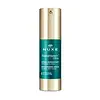What's inside
What's inside
 Key Ingredients
Key Ingredients

 Benefits
Benefits

 Concerns
Concerns

 Ingredients Side-by-side
Ingredients Side-by-side

Water
Skin ConditioningGlycerin
HumectantButyrospermum Parkii Butter
Skin ConditioningDimethicone
EmollientPrunus Armeniaca Kernel Oil
MaskingPentaerythrityl Tetraethylhexanoate
EmollientPanthenol
Skin ConditioningSilica
AbrasiveIsohexadecane
EmollientZea Mays Starch
AbsorbentPropylene Glycol
HumectantHydroxypropyl Tetrahydropyrantriol
Skin ConditioningCera Alba
EmollientStearic Acid
CleansingPalmitic Acid
EmollientPEG-100 Stearate
Glyceryl Stearate
EmollientPEG-20 Stearate
EmulsifyingStearyl Alcohol
EmollientTin Oxide
AbrasiveBis-PEG-18 Methyl Ether Dimethyl Silane
EmollientSorbitan Oleate
EmulsifyingDimethiconol
EmollientSodium Hyaluronate
HumectantArginine PCA
HumectantSerine
MaskingMyristic Acid
CleansingAlumina
AbrasiveDisodium EDTA
Isopropyl Titanium Triisostearate
EmollientHydrolyzed Hyaluronic Acid
HumectantHydrolyzed Linseed Extract
Skin ConditioningCitric Acid
BufferingAcetyl Dipeptide-1 Cetyl Ester
Skin ConditioningToluene Sulfonic Acid
Polysorbate 80
EmulsifyingAcrylamide/Sodium Acryloyldimethyltaurate Copolymer
Emulsion StabilisingBHT
AntioxidantPentaerythrityl Tetra-Di-T-Butyl Hydroxyhydrocinnamate
AntioxidantSodium Benzoate
MaskingPhenoxyethanol
PreservativeBenzoic Acid
MaskingCI 77491
Cosmetic ColorantCI 77492
Cosmetic ColorantCI 77499
Cosmetic ColorantCI 77891
Cosmetic ColorantMica
Cosmetic ColorantWater, Glycerin, Butyrospermum Parkii Butter, Dimethicone, Prunus Armeniaca Kernel Oil, Pentaerythrityl Tetraethylhexanoate, Panthenol, Silica, Isohexadecane, Zea Mays Starch, Propylene Glycol, Hydroxypropyl Tetrahydropyrantriol, Cera Alba, Stearic Acid, Palmitic Acid, PEG-100 Stearate, Glyceryl Stearate, PEG-20 Stearate, Stearyl Alcohol, Tin Oxide, Bis-PEG-18 Methyl Ether Dimethyl Silane, Sorbitan Oleate, Dimethiconol, Sodium Hyaluronate, Arginine PCA, Serine, Myristic Acid, Alumina, Disodium EDTA, Isopropyl Titanium Triisostearate, Hydrolyzed Hyaluronic Acid, Hydrolyzed Linseed Extract, Citric Acid, Acetyl Dipeptide-1 Cetyl Ester, Toluene Sulfonic Acid, Polysorbate 80, Acrylamide/Sodium Acryloyldimethyltaurate Copolymer, BHT, Pentaerythrityl Tetra-Di-T-Butyl Hydroxyhydrocinnamate, Sodium Benzoate, Phenoxyethanol, Benzoic Acid, CI 77491, CI 77492, CI 77499, CI 77891, Mica
Water
Skin ConditioningCoco-Caprylate/Caprate
EmollientHelianthus Annuus Seed Oil
EmollientArachidyl Alcohol
EmollientGlycerin
HumectantHydroxyethyl Acrylate/Sodium Acryloyldimethyl Taurate Copolymer
Emulsion StabilisingHydroxyethyl Urea
HumectantBehenyl Alcohol
EmollientTocopherol
AntioxidantParfum
MaskingArachidyl Glucoside
EmulsifyingPhenoxyethanol
PreservativeEthylhexylglycerin
Skin ConditioningAlbizia Julibrissin Bark Extract
MaskingDehydroacetic Acid
PreservativeCaffeine
Skin ConditioningSodium Gluconate
Skin ConditioningSodium Stearoyl Glutamate
CleansingButylene Glycol
HumectantPolysorbate 60
EmulsifyingSorbitan Isostearate
EmulsifyingBougainvillea Glabra Leaf Cell Extract
AntioxidantHyaluronic Acid
HumectantAmmonium Lactate
BufferingSodium Hydroxide
BufferingAlteromonas Ferment Extract
Skin ConditioningTheobroma Cacao Leaf Cell Extract
MaskingUndaria Pinnatifida Extract
Skin ConditioningCrocus Sativus Flower Extract
MaskingBenzyl Alcohol
PerfumingSodium Benzoate
MaskingDarutoside
Skin ConditioningWater, Coco-Caprylate/Caprate, Helianthus Annuus Seed Oil, Arachidyl Alcohol, Glycerin, Hydroxyethyl Acrylate/Sodium Acryloyldimethyl Taurate Copolymer, Hydroxyethyl Urea, Behenyl Alcohol, Tocopherol, Parfum, Arachidyl Glucoside, Phenoxyethanol, Ethylhexylglycerin, Albizia Julibrissin Bark Extract, Dehydroacetic Acid, Caffeine, Sodium Gluconate, Sodium Stearoyl Glutamate, Butylene Glycol, Polysorbate 60, Sorbitan Isostearate, Bougainvillea Glabra Leaf Cell Extract, Hyaluronic Acid, Ammonium Lactate, Sodium Hydroxide, Alteromonas Ferment Extract, Theobroma Cacao Leaf Cell Extract, Undaria Pinnatifida Extract, Crocus Sativus Flower Extract, Benzyl Alcohol, Sodium Benzoate, Darutoside
 Reviews
Reviews

Ingredients Explained
These ingredients are found in both products.
Ingredients higher up in an ingredient list are typically present in a larger amount.
Glycerin is already naturally found in your skin. It helps moisturize and protect your skin.
A study from 2016 found glycerin to be more effective as a humectant than AHAs and hyaluronic acid.
As a humectant, it helps the skin stay hydrated by pulling moisture to your skin. The low molecular weight of glycerin allows it to pull moisture into the deeper layers of your skin.
Hydrated skin improves your skin barrier; Your skin barrier helps protect against irritants and bacteria.
Glycerin has also been found to have antimicrobial and antiviral properties. Due to these properties, glycerin is often used in wound and burn treatments.
In cosmetics, glycerin is usually derived from plants such as soybean or palm. However, it can also be sourced from animals, such as tallow or animal fat.
This ingredient is organic, colorless, odorless, and non-toxic.
Glycerin is the name for this ingredient in American English. British English uses Glycerol/Glycerine.
Learn more about GlycerinPhenoxyethanol is a preservative that has germicide, antimicrobial, and aromatic properties. Studies show that phenoxyethanol can prevent microbial growth. By itself, it has a scent that is similar to that of a rose.
It's often used in formulations along with Caprylyl Glycol to preserve the shelf life of products.
Sodium Benzoate is a preservative. It's used in both cosmetic and food products to inhibit the growth of mold and bacteria. It is typically produced synthetically.
Both the US FDA and EU Health Committee have approved the use of sodium benzoate. In the US, levels of 0.1% (of the total product) are allowed.
Sodium benzoate works as a preservative by inhibiting the growth of bacteria inside of cells. It prevents the cell from fermenting a type of sugar using an enzyme called phosphofructokinase.
It is the salt of benzoic acid. Foods containing sodium benzoate include soda, salad dressings, condiments, fruit juices, wines, and snack foods.
Studies for using ascorbic acid and sodium benzoate in cosmetics are lacking, especially in skincare routines with multiple steps.
We always recommend speaking with a professional, such as a dermatologist, if you have any concerns.
Learn more about Sodium BenzoateWater. It's the most common cosmetic ingredient of all. You'll usually see it at the top of ingredient lists, meaning that it makes up the largest part of the product.
So why is it so popular? Water most often acts as a solvent - this means that it helps dissolve other ingredients into the formulation.
You'll also recognize water as that liquid we all need to stay alive. If you see this, drink a glass of water. Stay hydrated!
Learn more about Water